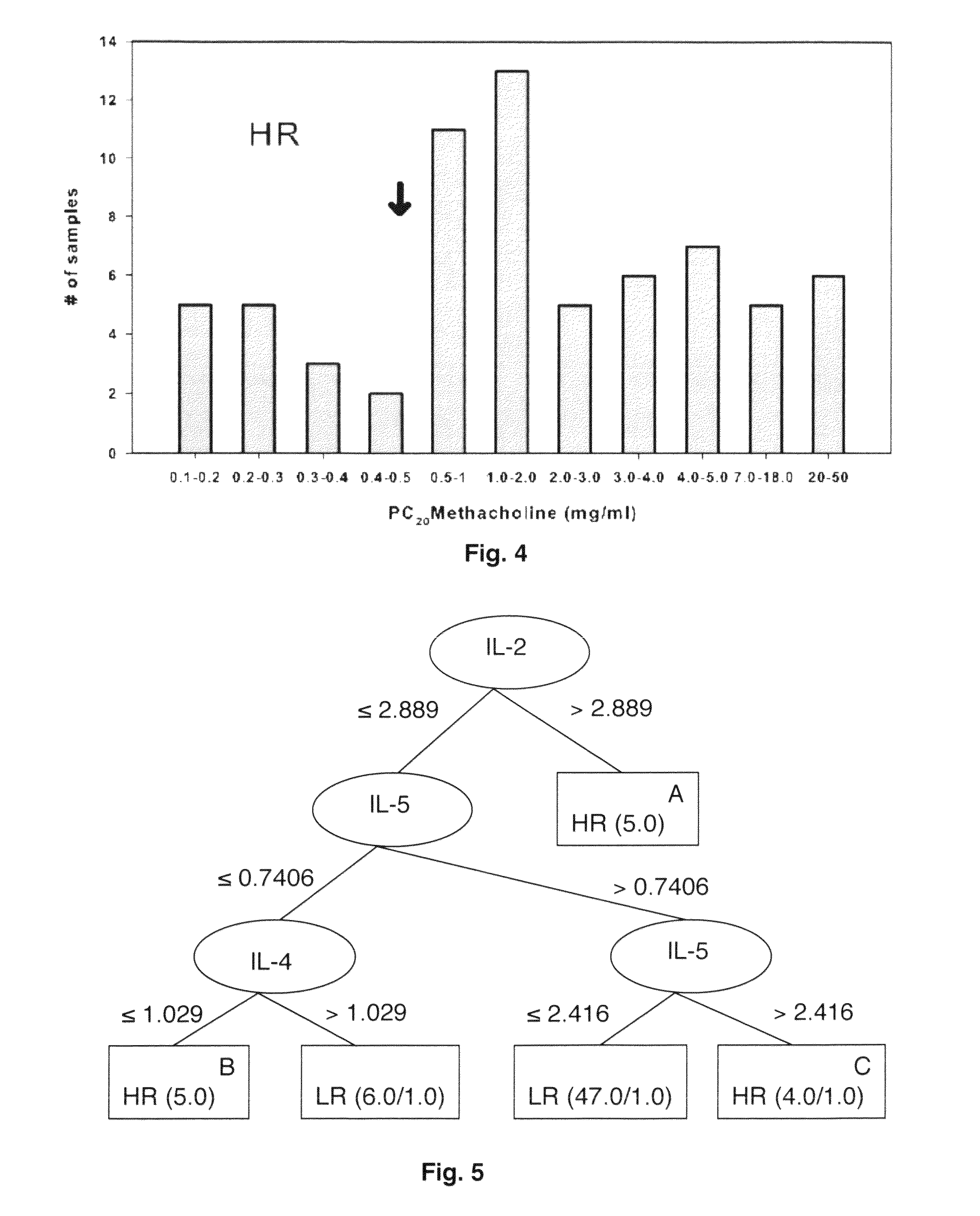Molecular phenotyping of severe asthma
a technology of asthma and molecular phenotyping, applied in the field of immunology and molecular biology, can solve problems such as lack of objective methods, and achieve the effect of facilitating clinical investigation
- Summary
- Abstract
- Description
- Claims
- Application Information
AI Technical Summary
Benefits of technology
Problems solved by technology
Method used
Image
Examples
example 1
Subjects
[0039]In the Severe Asthma Research Program, enrollees are categorized as 1) healthy volunteer, 2) non-severe asthma, and 3) severe asthma, on the basis of a standardized manual of procedures (MOP) based on an NHLBI workshop (Wenzel and Busse, 2007, Proceedings of the ATS workshop on Refractory Asthma, 2000). All enrollees have history, physical examination, spirometry, bronchodilator reversibility, allergy skin testing, and methacholine challenge testing. Healthy volunteers have normal lung function and negative methacholine challenge, no history of asthma, negative skin tests to common aeroallergens, and no need for any routine medications. Non-severe asthmatics have lung function that can be normalized using standard doses of inhaled corticosteroids, with or without long-acting beta-agonists or leukotriene modifiers; in addition, they must have at least 2 positive allergy skin tests. Severe asthmatics are defined according to ATS consensus for refractory asthma (Wenzel an...
example 2
[0040]Bronchoscopy and bronchoalveolar lavage were conducted according to the Severe Asthma Research Program manual of procedures. Briefly, after topical anesthesia, bronchoscopy was performed. Bronchoalveolar lavage was obtained using 2 aliquots of 50 ml each of 0.9% NaCl. Cells were separated by low speed centrifugation (400×g, 20 min), and supernatants frozen for subsequent analysis. Bronchoalveolar lavage and de-identified clinical information were obtained from the SARP for 84 randomly selected subjects matched for age and gender (Table I); by the SARP criteria, 43 were “non-severe” and 41 were “severe” asthmatics.
[0041]
TABLE IPhenotypeCharacteristicMen 30 (36%)Women 54 (64%)All SubjectsNot15 (34.9%)28 (65.1%)43 (100%)Severe (n = 43)Age of onset11.6 ± 10.418.6 ± 11.5 16 ± 11.5Baseline FEV1 (I) 3.7 ± 1 2.8 ± 0.63.14 ± 1§Baseline FEV1 (% pred.)85.4 ± 18.190.2 ± 16.288.5 ± 16.8§Baseline FVC (I) 5.3 ± 0.9 3.6 ± 0.7 4.2 ± 1.15§Baseline FVC (% pred.)97.7 ± 12.3...
example 3
[0043]Chemokine concentrations were determined based on a simultaneously measured standard curve using a logistic curve-fitting algorithm (Bio-Plex Manager 3.0 Software). The standard curve for each cytokine in this panel has a range between 2 to 5000 pg / ml. Sample data were used when duplicate measurements showed less than 10% difference.
PUM
| Property | Measurement | Unit |
|---|---|---|
| frequency | aaaaa | aaaaa |
| heat map | aaaaa | aaaaa |
| threshold | aaaaa | aaaaa |
Abstract
Description
Claims
Application Information
 Login to View More
Login to View More - R&D
- Intellectual Property
- Life Sciences
- Materials
- Tech Scout
- Unparalleled Data Quality
- Higher Quality Content
- 60% Fewer Hallucinations
Browse by: Latest US Patents, China's latest patents, Technical Efficacy Thesaurus, Application Domain, Technology Topic, Popular Technical Reports.
© 2025 PatSnap. All rights reserved.Legal|Privacy policy|Modern Slavery Act Transparency Statement|Sitemap|About US| Contact US: help@patsnap.com



